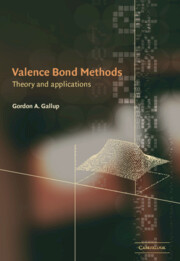Book contents
- Frontmatter
- Contents
- Preface
- List of abbreviations
- I Theory and two-electron systems
- 1 Introduction
- 2 H2 and localized orbitals
- 3 H2 and delocalized orbitals
- 4 Three electrons in doublet states
- 5 Advanced methods for larger molecules
- 6 Spatial symmetry
- 7 Varieties of VB treatments
- 8 The physics of ionic structures
- II Examples and interpretations
- References
- Index
8 - The physics of ionic structures
Published online by Cambridge University Press: 13 August 2009
- Frontmatter
- Contents
- Preface
- List of abbreviations
- I Theory and two-electron systems
- 1 Introduction
- 2 H2 and localized orbitals
- 3 H2 and delocalized orbitals
- 4 Three electrons in doublet states
- 5 Advanced methods for larger molecules
- 6 Spatial symmetry
- 7 Varieties of VB treatments
- 8 The physics of ionic structures
- II Examples and interpretations
- References
- Index
Summary
The existence of many ionic structures in MCVB wave functions has often been criticized by some workers as being unphysical. This has been the case particularly when a covalent bond between like atoms is being represented. Nevertheless, we have seen in Chapter 2 that ionic structures contribute to electron delocalization in the H2 molecule and would be expected to do likewise in all cases. Later in this chapter we will see that they can also be interpreted as contributions from ionic states of the constituent atoms. When the bond is between unlike atoms, it is to be expected that ionic structures in the wave function will also contribute to various electric moments, the dipole moment being the simplest. The amounts of these ionic structures in the wave functions will be determined by a sort of “balancing act” in the variation principle between the “diagonal” effects of the ionic state energies and the “off-diagonal” effect of the delocalization.
In this chapter we will also focus on the dipole moment of molecules. With these, some of the most interesting phenomena are the molecules for which the electric moment is in the “wrong” direction insofar as the atomic electronegativities are concerned. CO is probably the most famous of these cases, but other molecules have even more striking disagreements. One of the larger is the simple diatomic BF. We will take up the question of the dipole moments of molecules like BF in Chapter 12.
Information
- Type
- Chapter
- Information
- Valence Bond MethodsTheory and Applications, pp. 111 - 118Publisher: Cambridge University PressPrint publication year: 2002
